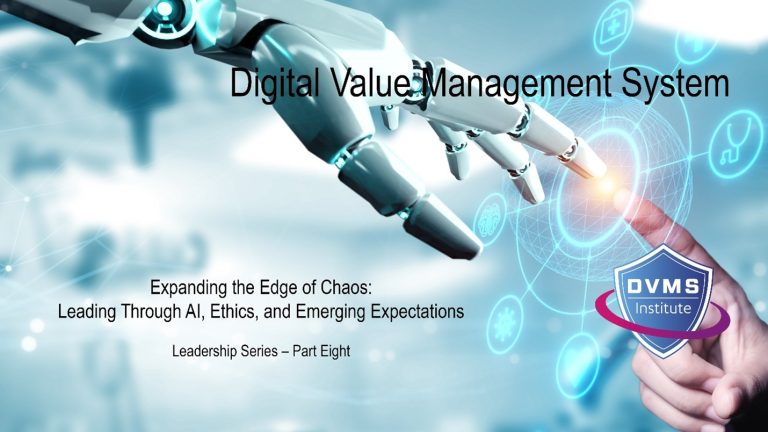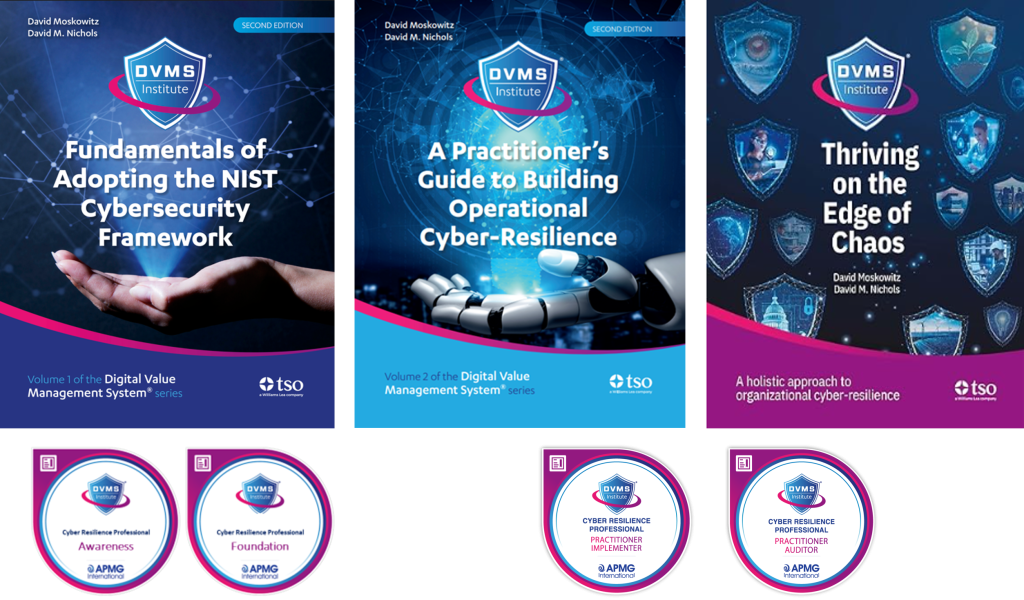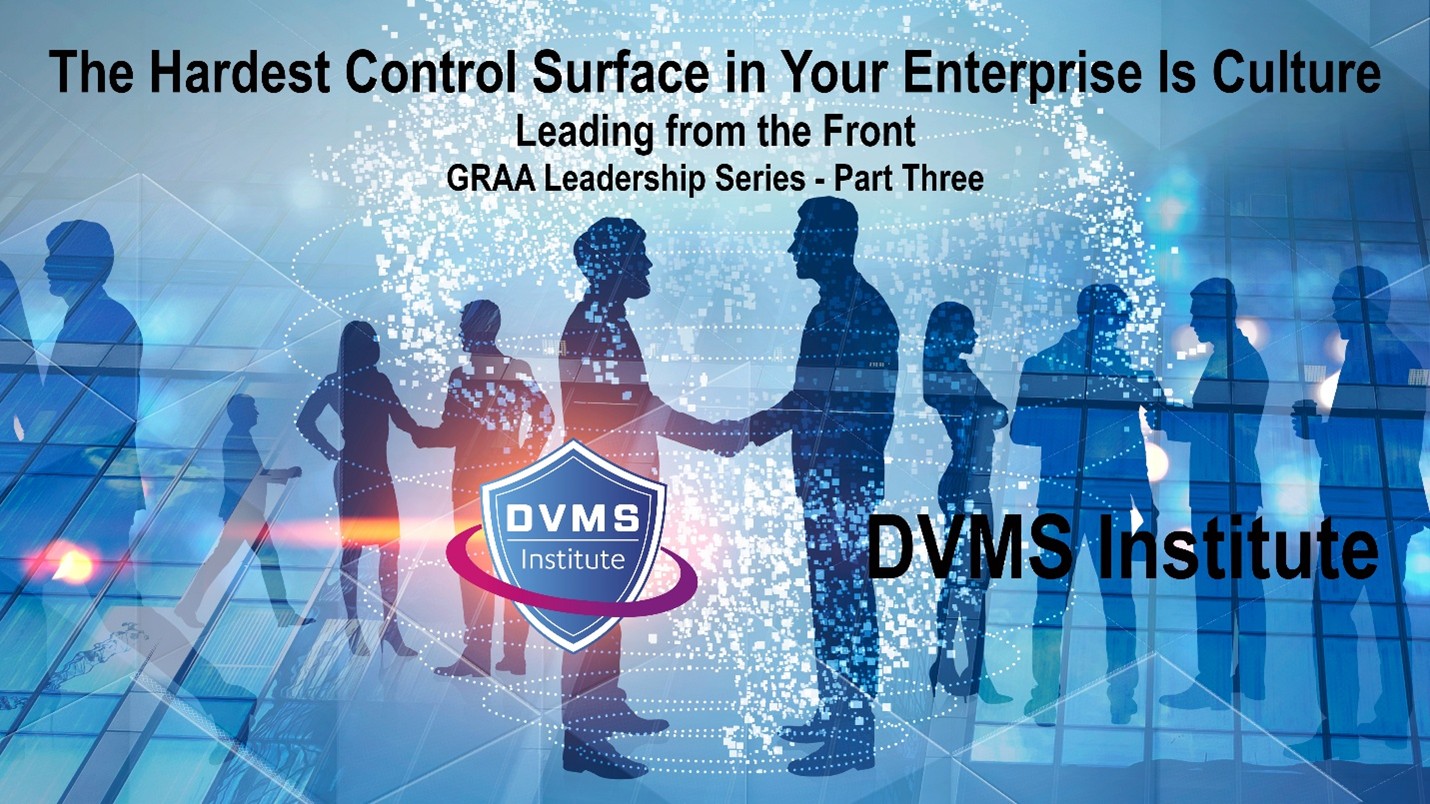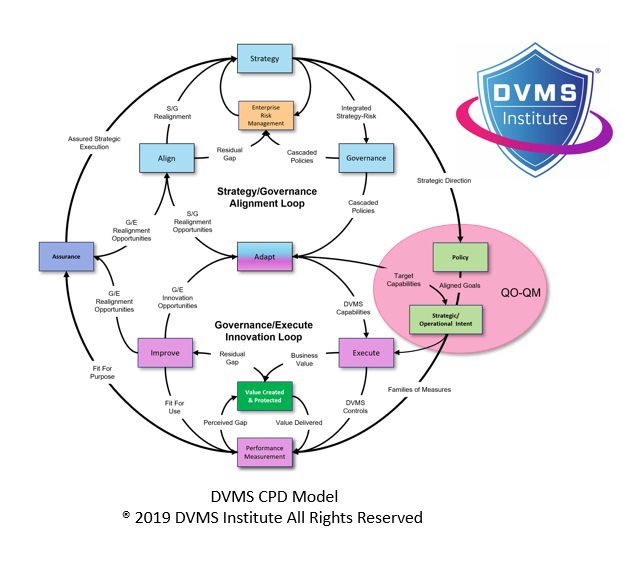Expanding the Edge of Chaos: Leading Through AI, Ethics, and Emerging Expectations – A Leadership Call to Action – Part Eight
David Nichols – Co-Founder and Executive Director of the DVMS Institute
Beyond the Current Edge
In Part Seven, we moved from principles to practice. We examined how leadership is critically tested during transformations, mergers and acquisitions, supply chain management, and enterprise resilience initiatives. In each case, the difference between failure and success was not technology or spreadsheets but leadership’s capacity to coordinate value, risk, and culture under pressure.
Part Eight extends further outward. The edge of chaos is a dynamic space where stability and adaptability meet and expand. It is no longer limited to internal organizational areas. It includes artificial intelligence, digital ethics, stakeholder trust, and societal expectations. For clarity, I’ll use the full term “the edge of chaos” throughout, but occasionally shorten it to “the edge” as a shorthand.
Navigating this frontier requires leaders to recognize what is often hidden: the connections between leadership intent, organizational structures, and cultural behavior. They must identify cultural gaps that weaken resilience and understand which hard and soft skills must be developed to bridge them. The complexity can seem overwhelming, like a multidimensional matrix that no one can fully chart on their own.
This is why approaches like the DVMS – Adaptive Edge Platform are essential. Guided by Kaia, the Adaptive Edge AI agent doesn’t eliminate complexity but helps make sense of it. It assists leaders in understanding interdependencies, revealing evidence of capability, and mapping a path forward. This process transforms the edge of chaos from a place of fear into a strategic advantage.
The Edge of Chaos in AI and Algorithmic Governance
Artificial intelligence is transforming industries more rapidly than any previous wave of technology. It offers efficiency, innovation, and new ways to create value. However, it also increases risks, including hidden bias in algorithms, blurred accountability across systems, and unintended consequences that can develop rapidly.
Too often, organizations treat AI adoption solely as a technical project. Leaders focus on model accuracy, infrastructure, or vendor contracts, while neglecting the cultural and behavioral aspects of their work. The result is predictable: technology that functions but trust that collapses. Customers resist opaque decision-making. Regulators step in when bias appears. Employees become uneasy when algorithms make judgments without clear accountability.
This is where the Create–Protect–Deliver (CPD) Model offers clarity. At the leadership level, Create involves sponsoring innovation responsibly and setting a vision for AI that focuses on opportunities while remaining ethically grounded. Protect entails establishing guardrails to manage systemic risks, such as conducting bias audits, ensuring data integrity, and maintaining clear lines of accountability. Deliver requires that AI adoption aligns with organizational values and stakeholder trust, not just efficiency.
The Adaptive Edge Platform, guided by Kaia, strengthens this posture by helping leaders see what is often hidden from view. Kaia does not govern AI, but it acts as an advisor, surfacing the dependencies between technical adoption and cultural readiness. It reveals where structures may not effectively reinforce leadership intent around transparency, or where frontline behaviors undermine stated values. It highlights the skills—both hard, such as data stewardship, and soft, like ethical judgment—that leaders must develop to sustain trust. Considering these interdependencies, Kaia simplifies complexity and equips leaders to make governance decisions with clarity and confidence.
By surfacing these interdependencies and simplifying them into actionable insights, Kaia allows leaders to orchestrate AI adoption at the edge of chaos—not as a leap into the unknown, but as a deliberate act of leadership.
The Edge of Chaos in Digital Ethics
Ethics has become a crucial issue in the digital age. Data privacy, algorithmic fairness, and transparency are not just compliance issues—they significantly impact a company’s competitive advantage. Organizations that ignore ethics risk harming their reputation; those that embed ethics into their culture build resilience and trust.
The 3D Knowledge Model provides a clear perspective. On the Z-axis, leaders should convey an ethical narrative beyond slogans to define the organizational core values. On the Y-axis, structures need to include accountability mechanisms that make ethical decisions essential and actionable. On the X-axis, behaviors must consistently demonstrate integrity—employees acting in accordance with the values leaders promote.
The Adaptive Edge Platform enhances this by highlighting to leaders where cultural gaps compromise ethics. Kaia can highlight when leadership rhetoric (Z-axis) surpasses structures (Y-axis) or behaviors (X-axis). It can identify the hard skills needed, such as data literacy and risk analysis, as well as the soft skills required—like empathy, judgment, and courage. By revealing this multidimensional matrix, the Adaptive Edge Platform doesn’t provide ethical answers but instead gives leaders the clarity to implement them.
Ethics at the edge of chaos isn’t about perfection but consistency between what leaders say, how the organization is structured, and how people behave. With Kaia’s guidance, leaders can identify when these elements drift apart and take steps to close the gap before trust begins to erode.
The Edge of Chaos in Stakeholder Trust
Trust has always been a key leadership asset, but in the digital age, it has become currency. It is fragile, hard to earn, and easily lost. A single misstep, such as mishandled transparency during a cybersecurity breach, unmet ESG commitments, or inconsistent messaging, can damage trust faster than technical fixes can restore it.
Leadership should see trust not just as a communication issue but as an outcome of consistency. Trust increases when leadership goals align with organizational structures and are reinforced by effective behaviors. When there is misalignment, trust declines.
The Adaptive Edge Platform reveals these dynamics. Kaia can show leaders the dependencies where trust is most at risk: a policy that signals openness but a structure that discourages escalation; a commitment to sustainability paired with incentives that reward short-term profit. By identifying these gaps, the Adaptive Edge Platform helps leaders adjust both hard and soft levers—structures, incentives, behaviors, and narratives—to reinforce trust rather than undermine it.
In this context, the edge of chaos becomes a place where trust is tested and built. Leaders who use tools like the Adaptive Edge Platform to simplify complexity can turn volatility into an opportunity to demonstrate consistency and build trust.
The Edge of Chaos in Societal Expectations
Today’s organizations are scrutinized by society more than ever before. Stakeholders expect more than just profit; they want transparency and responsibility in sustainability, equity, and social impact. Organizations are judged not only on their outputs but also on how they affect or harm the communities and environments in which they operate.
For some leaders, this may feel like an external burden. However, through the DVMS approach, societal expectations can be reframed as essential to resilience. When sustainability, equity, and impact are integrated into organizational culture, they enhance rather than detract from value creation.
The Adaptive Edge Platform supports this integration. Kaia can assist leaders in understanding the interconnections between societal expectations and organizational capabilities, identifying which skills require development, which cultural narratives need reinforcement, and where behavioral gaps threaten credibility. It highlights hard skills (such as sustainability reporting or supply chain auditing) and soft skills (like empathy and stakeholder engagement) that help bridge the gap.
Kaia helps leaders incorporate societal expectations into the organization’s core operations by simplifying these complexities into a clear path forward. At the edge of chaos, where legitimacy is constantly challenged, this integration becomes a source of resilience.
Patterns Emerging at the New Edge of Chaos
Familiar patterns emerge throughout AI, including ethics, trust, and societal expectations. Success occurs when leaders integrate these areas into culture and capability, not just as add-ons. Failure happens when they are overlooked, delegated, or handled separately.
Assimilation sets organizations apart. In mergers, it represented cultural growth rather than sacrifice. Now, it involves integrating AI governance, ethics, trust, and societal responsibility into the organizational core.
The Adaptive Edge Platform is essential here. Kaia reveals the complex matrix behind these challenges: the hidden links between leadership, structure, and behavior; the cultural gaps that undermine resilience; and the skills—both hard and soft—needed to close these gaps. By making this complexity clear and manageable, Kaia helps leaders identify blind spots and enhance their resilience.
The pattern is clear: Leaders who recognize and manage interdependencies succeed at the edge of chaos, while leaders who overlook them fail.
Practical Tools for Executives
Part Eight must stay practical. Leaders can expand the Z-axis audit from Part Six into these new frontiers by asking: Does our leadership story align with our structures and behaviors in overseeing AI adoption, digital ethics, stakeholder trust, and meeting social expectations? Where are the points of misalignment, and how can they be corrected?
The CPD Model can also be used in these areas. Leaders might ask: What are we creating with AI and other new technologies? What do we need to guard against—bias, misuse, or reputational damage? How are we implementing it—ensuring that adoption aligns with our culture and values, rather than contradicting them? Regularly asking these questions turns complexity into clarity.
The Adaptive Edge Platform strengthens these practices by providing evidence-based visibility. Kaia does not dictate governance or make decisions. Instead, she advises leaders by surfacing hidden dependencies, highlighting cultural gaps, and clarifying the hard and soft skills required to close them. By simplifying the multidimensional systems matrix into a clear pathway forward, Kaia enables leaders to approach the edge of chaos not as an overwhelming threat but as a landscape that can be navigated confidently.
The Next Horizon of Leadership
Part Eight has expanded the chaos boundary beyond organizational practices into the emerging frontiers of AI, ethics, trust, and societal expectations. It demonstrates that the boundary is not fixed but a shifting frontier, requiring new forms of leadership coordination.
The lessons are simple. Leading near chaos requires more than instinct. Understanding interdependencies, proof of skill, and courage are needed to bridge cultural gaps. It involves blending technology, ethics, and expectations into the organizational core culture. Additionally, tools like the Adaptive Edge Platform, guided by Kaia, help make complexity easier to navigate, providing leaders with a clear path they can trust.
As we look ahead to Part Nine, we will explore how these challenges cross borders, ecosystems, and societies. The edge of chaos is not only organizational but also global in scope. Leading in this context will require coordinating within organizations and across networks, industries, and countries.
For now, Part Eight reminds us that the edge of chaos is where leadership achieves its highest purpose—not just as an idea, but as real action on the most active frontiers of our era.
About the Author

Dave is the Executive Director of the DVMS Institute.
Dave spent his “formative years” on US Navy submarines. There, he learned complex systems, functioning in high-performance teams, and what it takes to be an exceptional leader. He took those skills into civilian life and built a successful career leading high-performance teams in software development and information service delivery.
Digital Value Management System® (DVMS)
The DVMS is an adaptive, culture-enabled governance overlay designed to help organizations of any size, scale, or complexity transition from static, paper-based governance models to a living, evidence-based system of Governance, Resilience, Assurance, and Accountability (GRAA).
At its core, the DVMS is a simple but powerful integration of:
-
Governance Intent – shared expectations and accountabilities.
-
Operational Capability – how the business actually performs
-
Assurance Evidence – proof that intended outcomes are being achieved
Rather than adding more complexity, a DVMS integrates fragmented frameworks and practices such as NIST CSF, GRC, ITSM, DevOps, and AI into a unified overlay system that enables leaders and regulators to see, in real time, whether the digital business is working as intended—and whether the risks that matter most are being managed proactively.
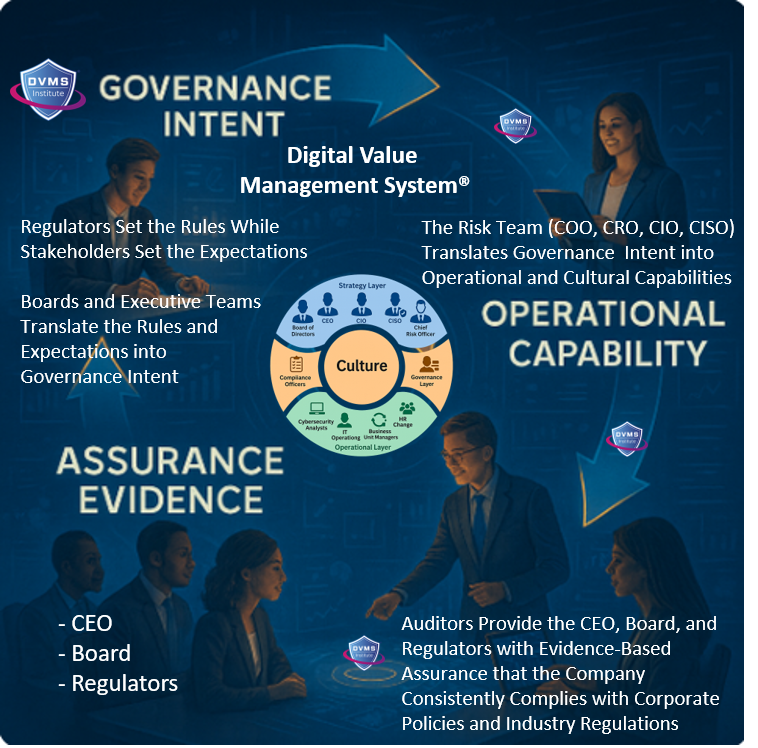
Through its MVC, CPD, 3D Knowledge, and FastTrack Models, a DVMS turns this integration into three distinctive capabilities:
A Governance Overlay that replaces fragmentation with unity. The DVMS provides organizations with a structured way to connect strategy with day-to-day execution. Leaders gain a consistent mechanism to direct, measure, and validate performance—across every system responsible for digital value.
A Behavioral Engine that drives high-trust, high-velocity decision-making. The DVMS embeds decision models and behavioral patterns that help teams think clearly and act confidently, even in uncertain situations. It is engineered to reduce friction, prevent blame-based cultures, and strengthen organizational reliability.
A Learning System that makes culture measurable, adaptable, and scalable. Culture becomes a managed asset—not an abstract concept. The DVMS provides a repeatable way to observe behavior, collect evidence, learn from outcomes, and evolve faster than threats, disruptions, or market shifts.
DVMS Organizational Benefits
Instead of replacing existing operational frameworks, the DVMS elevates them—connecting and contextualizing their data into actionable intelligence that validates performance and exposes the reasons behind unmet outcomes.
By adopting a DVMS, organizations are positioned to:
- Maintain Operational Stability Amidst Constant Digital Disruption
- Deliver Digital Value and Trust Across A Digital Ecosystem
- Satisfy Critical Regulatory and Certification Requirements
- Leverage Cyber Resilience as a Competitive Advantage
DVMS Leadership Benefits
The Digital Value Management System (DVMS) provides leaders with a unified, evidence-based approach to governing and enhancing their digital enterprise, aligning with regulatory requirements and stakeholder expectations.
For the CEO, the DVMS provides a clear line of sight between digital operations, business performance, and strategic outcomes—turning governance and resilience into enablers of growth and innovation rather than cost centers.
For the Board of Directors, the DVMS provides ongoing assurance that the organization’s digital assets, operations, and ecosystem are governed, protected, and resilient—supported by evidence-based reporting that directly links operational integrity to enterprise value and stakeholder trust.
For the CIO, CRO, CISO, and Auditors: an integrated, adaptive, and culture-driven governance and assurance management system that enhances digital business performance, resilience, trust, and accountability
DVMS White Papers
The three whitepapers below present a coherent progression that shifts organizations from compliance-driven thinking to a modern system of Governance, Resilience, Assurance, and Accountability (GRAA). Collectively, the three papers define a comprehensive system for building and governing resilient digital enterprises, grounded in evidence rather than assumptions.
The Assurance Mandate Paper sets the stage by showing why traditional GRC artifacts provide only reassurance—not evidence—and calls boards to demand forward-looking proof that their organizations can continue to create, protect, and deliver value under stress.
The Assurance in Action Paper elevates the conversation from leadership intent to managerial execution, demonstrating how the DVMS operationalizes resilience by translating outcomes into Minimum Viable Capabilities, connecting frameworks through the Create–Protect–Deliver model, and generating measurable assurance evidence that managers can use to demonstrate real performance rather than activity.
The Governing by Assurance Paper elevates the approach to the policy and regulatory level, showing how DVMS functions as a learning overlay system that links governance intent, operational capability, and verifiable evidence into a continuous loop—enabling regulators, agencies, and enterprises to govern by outcomes rather than checklists and to prove capability with measurable, auditable performance data.
DVMS Cyber Resilience Certified Training Programs
DVMS Cyber Resilience Awareness Training
The DVMS Cyber Resilience Awareness course and its accompanying body of knowledge publication educate all employees on the fundamentals of digital business, its associated risks, the NIST Cybersecurity Framework, and their role within a shared model of governance, resilience, assurance, and accountability for creating, protecting, and delivering digital value.
This investment fosters a culture that is prepared to operate within a system capable of transforming systemic cyber risks into operational resilience.
DVMS NISTCSF Foundation Certification Training
The DVMS NISTCSF Foundation certification training course and its accompanying body of knowledge publications provide ITSM, GRC, Cybersecurity, and Business professionals with a detailed understanding of the NIST Cybersecurity Framework and its role in a shared model of governance, resilience, assurance, and accountability for creating, protecting, and delivering digital value.
This investment fosters IT, GRC, Cybersecurity, and Business professionals with the skills to operate within a system capable of transforming systemic cyber risks into operational resilience.
DVMS Cyber Resilience Practitioner Certification Training
The DVMS Practitioner certification training course and its accompanying body of knowledge publications teach ITSM, GRC, Cybersecurity, and Business practitioners how to elevate investments in ITSM, GRC, Cybersecurity, and AI business systems by integrating them into a unified governance, resilience, assurance, and accountability system designed to proactively identify and mitigate the cyber risks that could disrupt operations, erode resilience, or diminish client trust.
This investment fosters IT, GRC, Cybersecurity, and Business practitioners with the skills to assess, design, implement, operationalize, and continually innovate a Digital Value Management System® program that operationalizes a shared model of governance, resilience, assurance, and accountability for creating, protecting, and delivering digital value.
Company Brochures and Presentation
Explainer Videos
- DVMS Architecture Video: David Moskowitz explains the DVMS System
- DVMS Case Study Video: Dr. Joseph Baugh Shares His DVMS Story.
- DVMS Overlay Model – What is an Overlay Model
- DVMS MVC ZX Model – Powers the CPD
- DVMS CPD Model – Powers DVMS Operations
- DVMS 3D Knowledge Model – Powers the DVMS Culture
- DVMS FastTrack Model – Enables A Phased DVMS Adoption
Digital Value Management System® is a registered trademark of the DVMS Institute LLC.
® DVMS Institute 2025 All Rights Reserved

